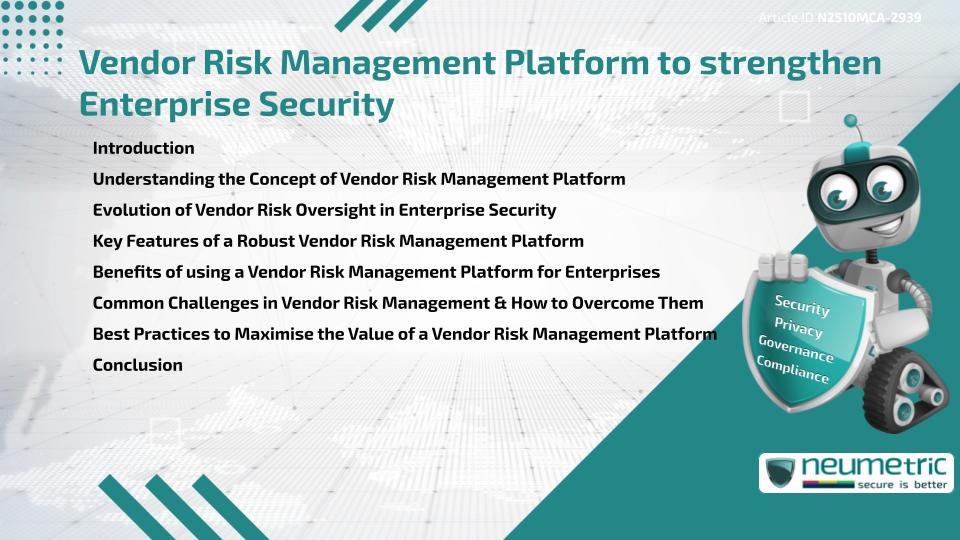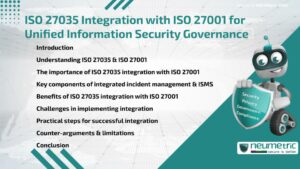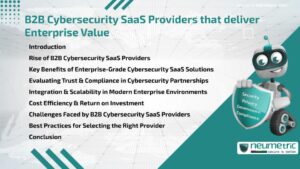Table of Contents
ToggleIntroduction
A Vendor Risk Management platform helps Organisations safeguard their data, assets & reputation by evaluating & monitoring the Security Posture of Third Party Vendors. In an age where Supply Chain attacks & Data Breaches are increasingly common, enterprises cannot afford to ignore Risks stemming from external Partners. This article explores how a Vendor Risk Management platform strengthens enterprise security, its evolution, essential features, benefits & Best Practices for implementation.
Enterprises depend on a wide range of Third Party Providers for software, hardware, Cloud services & Business Operations. However, each partnership introduces new Risks — from data exposure & regulatory violations to operational disruptions. Implementing a Vendor Risk Management platform helps Organisations identify, assess, mitigate & continuously monitor these Threats, providing an essential layer of protection across the supply chain.
Understanding the Concept of Vendor Risk Management Platform
A Vendor Risk Management platform is a centralised system that helps enterprises evaluate, track & mitigate potential Risks arising from external Vendors & Service Providers. It automates Risk Assessments, Compliance tracking & Reporting processes to ensure continuous oversight of Third Party activities.
Such platforms often include automated Questionnaires, Scoring mechanisms & Dashboards that visualise Vendor Risk levels. This helps Security & Compliance teams make informed decisions quickly & effectively.
Evolution of Vendor Risk Oversight in Enterprise Security
Historically, Vendor Risk Management was a manual, Checklist-driven process focused primarily on Contractual Compliance. Over time, as digital transformation accelerated, enterprises began depending on hundreds or even thousands of Vendors, each with potential Vulnerabilities.
Modern Vendor Risk Management platforms evolved to automate these Assessments, integrating with Governance, Risk & Compliance [GRC] Frameworks & Security Monitoring Tools. This transition enabled Organisations to detect anomalies in real time & respond proactively, rather than reactively, to emerging Threats.
Key Features of a Robust Vendor Risk Management Platform
An effective Vendor Risk Management platform typically includes:
- Automated Risk Assessments: Dynamic Questionnaires & scoring to evaluate Vendor security maturity.
- Continuous Monitoring: Ongoing tracking of Vendor behavior, Compliance & Incident Reporting.
- Centralised Repository: Consolidated storage of Vendor data, Audit records & Compliance documentation.
- Integration Capabilities: Connection with SIEM, GRC & ticketing systems for unified visibility.
- Analytics & Reporting: Real-time dashboards & trend analysis for executive oversight.
These features not only streamline security workflows but also support Enterprise Compliance with Frameworks such as ISO 27001, SOC 2 & HIPAA.
Benefits of using a Vendor Risk Management Platform for Enterprises
Deploying a Vendor Risk Management platform provides multiple advantages:
- Improved Visibility: Organisations gain a unified view of Vendor performance & security health.
- Enhanced Compliance: Automated documentation simplifies Audits & ensures Regulatory adherence.
- Reduced Risk Exposure: Continuous Assessment minimises chances of breaches from Third Party Vulnerabilities.
- Operational Efficiency: Automation reduces manual workload & accelerates Vendor onboarding.
- Stronger Relationships: Transparent communication builds Trust with Vendors & Stakeholders.
By incorporating such a platform, enterprises can create a more resilient & secure ecosystem.
Common Challenges in Vendor Risk Management & How to Overcome Them
Enterprises often face several obstacles while adopting Vendor Risk Management practices, including:
- Data Overload: Managing vast amounts of Vendor data can be overwhelming.
Solution: Use automated categorisation & machine learning filters to prioritise high-Risk Vendors. - Limited Resources: Smaller teams struggle to evaluate numerous Vendors.
Solution: Adopt tiered Assessment Frameworks to focus efforts where Risk is greatest. - Lack of Integration: Disconnected systems hinder effective monitoring.
Solution: Choose platforms that integrate seamlessly with existing IT & Compliance systems.
Addressing these challenges requires a balanced combination of Technology, Process & Governance.
Best Practices to Maximise the Value of a Vendor Risk Management Platform
To optimise the value derived from a Vendor Risk Management platform, Organisations should:
- Define clear Vendor Risk categories & criteria.
- Conduct initial due diligence before onboarding any Vendor.
- Implement periodic Reassessments based on changing Threat landscapes.
- Use automation to manage Vendor communications & reminders.
- Train internal teams on interpreting platform metrics & dashboards.
Consistency in applying these Best Practices ensures long-term enterprise Security & Compliance.
Conclusion
A Vendor Risk Management platform is no longer optional for modern enterprises. It acts as a strategic enabler for Risk visibility, Operational efficiency & Regulatory Compliance. By embedding Vendor Risk Management within enterprise security programs, Organisations can effectively strengthen their defense against evolving Threats.
Takeaways
- Vendor Risk Management platforms automate & streamline Third Party Risk Assessment.
- They enhance Visibility, Compliance & Vendor Accountability.
- Continuous Monitoring ensures timely detection of Security Gaps.
- Strategic adoption fosters a culture of Risk awareness across the Organisation.
FAQ
What is a Vendor Risk Management platform?
It is a centralised Software Solution that helps enterprises evaluate, monitor & mitigate Risks associated with Third Party Vendors.
Why do enterprises need a Vendor Risk Management platform?
It helps identify & manage Vulnerabilities introduced by external service providers, reducing overall enterprise Risk exposure.
How does a Vendor Risk Management platform enhance Compliance?
By automating data collection, Risk scoring & Reporting, it ensures adherence to Standards such as ISO 27001 & SOC 2.
What types of Risks can a Vendor Risk Management platform detect?
It can identify Operational, Security, Compliance & Reputational Risks in Vendor ecosystems.
Is a Vendor Risk Management platform suitable for Small Businesses?
Yes, many platforms offer scalable features suitable for smaller Organisations with fewer Vendors.
How often should Vendors be reassessed using the platform?
Vendors should be reassessed at least annually or more frequently if critical changes occur.
What is the difference between Vendor Risk Management & Third Party Risk Management?
Vendor Risk Management focuses specifically on Suppliers & Service Providers, while Third Party Risk Management covers all external entities, including Partners & Contractors.
Need help for Security, Privacy, Governance & VAPT?
Neumetric provides organisations the necessary help to achieve their Cybersecurity, Compliance, Governance, Privacy, Certifications & Pentesting needs.
Organisations & Businesses, specifically those which provide SaaS & AI Solutions in the Fintech, BFSI & other regulated sectors, usually need a Cybersecurity Partner for meeting & maintaining the ongoing Security & Privacy needs & requirements of their Enterprise Clients & Privacy conscious Customers.
SOC 2, ISO 27001, ISO 42001, NIST, HIPAA, HECVAT, EU GDPR are some of the Frameworks that are served by Fusion – a SaaS, multimodular, multitenant, centralised, automated, Cybersecurity & Compliance Management system.
Neumetric also provides Expert Services for technical security which covers VAPT for Web Applications, APIs, iOS & Android Mobile Apps, Security Testing for AWS & other Cloud Environments & Cloud Infrastructure & other similar scopes.
Reach out to us by Email or filling out the Contact Form…





